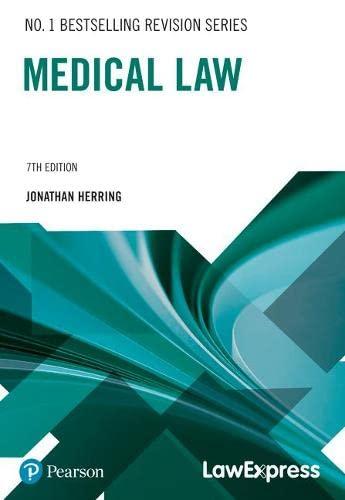Question
I am confused and researching just confuses me more. Can I get some help with this? How do I format this? DIRECTIONS For this performance
I am confused and researching just confuses me more. Can I get some help with this? How do I format this?
DIRECTIONS
For this performance assessment you will complete a brief for the Case Study for problem 1-3 of Chapter 1. 1. In your book, go to the very end of Chapter 1 to the section titled Business Scenarios and Case Problems. Read Problem 1-3 (page 28 of the book).
2. Create a Case Study Brief on this problem in the IRAC format.
I = ISSUE
R = RULE
A = APPLICATION
C = CONCLUSION
3. Include all relevant facts in the summary. And, include the issue before the court (what needs to be decided) clearly and concisely and phrase in the form of a question
4. Utilize the information provided in the book to identify the rule of lawthat is applicable to this case. Identify not just the topics but the rule of law itself (For example: you would not just identify ""Supremacy Clause", you would state "The Supremacy Clause states that when there is a direct conflict between a federal and a state law, the state law is rendered invalid - the federal law is 'supreme'.)
5. Complete a thorough analysis of the case - and applicationof the relevant law (the one that you identified in #4) to the specific facts of the case (the ones that you identified in #3)
6. Once you have completed your application/analysis, you will be able to come to a conclusion (this is a simple answer to the question you identified in #3).
Remember:This is an analysis of a case - not an option exercise. So, you should not be using words like "I believe" or "I think". The analysis you provide should be free of bias and supposition.
NOTE: The goal of completing a Case Study Brief is for anyone to be able to pick up your document and know: 1. What was the issue addressed in the case and 2. What is the proper application of the law to that issue. It should be a "nutshell" look at the case; everything needed to know about the case in a very concise format.
1:3 Equal Protection.Abbott Laboratories licensed SmithKline Beecham Corp. to market an Abbott human immunodeficiency virus (HIV) drug in conjunction with one of SmithKline's drugs. Abbott then increased the price of its drug fourfold, forcing SmithKline to increase its prices and thereby driving business to Abbott's own combination drug. SmithKline filed a suit in a federal district court against Abbott. During jury selection, Abbott struck the only self-identified gay person among the potential jurors. (The pricing of HIV drugs is of considerable concern in the gay community.) Could the equal protection clause be applied to prohibit discrimination based on sexual orientation in jury selection? Discuss. [SmithKline Beecham Corp. v. Abbott Laboratories, 740 F.3d 471 (9th Cir. 2014)]
Step by Step Solution
There are 3 Steps involved in it
Step: 1

Get Instant Access to Expert-Tailored Solutions
See step-by-step solutions with expert insights and AI powered tools for academic success
Step: 2

Step: 3

Ace Your Homework with AI
Get the answers you need in no time with our AI-driven, step-by-step assistance
Get Started


